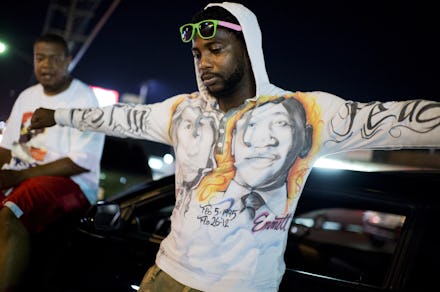60 Years Later, Emmett Till's Death Is More Relevant Than Ever

Even from the balcony, you can recognize Mike Brown's beard.
Not "Mike-Mike's" — the 18-year-old shot and killed by Officer Darren Wilson in Ferguson, Missouri, in August 2014 — but his father, Mike Brown Sr., the one who was left to grieve.
Brown's limbs look heavy. His cap sits low. He walks to the podium like he's carrying the pain in his shoes and the palms of his hands. In front of him sits a packed auditorium, and behind him, rows of chairs filled by black families who've endured similar tragedies: the death of a loved one by police or vigilante violence, and the frenzied aftermath — the vigils, the funerals, the protests, the taxing rinse and repeat — that inevitably follows.
"His nickname was Mike-Mike and his favorite color was blue," Brown says into the microphone. A smiling headshot of his son is projected onto the screen above.
Few of the the people gathered here — at Cleveland State University for the first-ever Movement for Black Lives convening in July — will forget where they were when they heard that a teenaged black boy had been shot dead by police a stone's throw outside of St. Louis and left in the street for four and a half sweltering hours. Few will forget Brown Sr.'s tribute, either, which ends with a stirring call to arms:
"This is my son. This is why I fight."
But there's something else about this day. Mike-Mike's family is present, of course, along with Trayvon Martin's, Rekia Boyd's, Jordan Davis' and others — all folks whose children were killed and buried within the past few years, a decade ago at most.
Then there's the family of Emmett Till. Despite having been killed more than half a century ago, a solid two dozen of his descendants gather onstage — by far the biggest such coalition that managed the trek to Ohio this weekend. We have heard Till's name before. But our Twitter-practiced thumbs are less familiar with its contours. It belongs to another era.
And still, it matters. Sixty years ago today, on Aug. 28, 1955, Till was kidnapped from his great-uncle's home in Money, Mississippi, and taken to a barn by two white men. There they beat him, gouged out one of his eyes, shot him through the head and dumped his body into the nearby Tallahatchie River with a cotton gin fan tied around his neck to weigh it down under the water.
He was 14 years old. They killed him because they thought he had whistled at a white woman at a grocery story two days prior.
In a staggering development, Till's mother, Mamie Till Bradley, decided to hold an open-casket memorial for her son. The world needed to see him, she said. She allowed photographers from news outlets across the country to snap pictures of his caved-in face and feature the image in their pages, drawing national attention to the South's ongoing humanitarian crisis and galvanizing what became the Civil Rights Movement.
The parallels to today are remarkable. In an age when the fact of routine violence against black people in the United States is only truly believed when captured visually, Mamie Till Bradley looks like a prophet. She knew the power of seeing her son's dead body, and the horror it might elicit. She knew that justice for her baby rested on making his suffering undeniable.
"This is my son. This is why I fight." — Mike Brown Sr.
This much is clear: There is no limit to the ways in which the murder and mutilation of black bodies in America will be justified. Whether it's a wolf whistle, a poorly timed hand gesture or the gall to run away from a police officer, black life too often leans on the discretion of an itchy white trigger finger, around which the state will subsequently close ranks to protect. Without seeing their bodies laid out on the ground, mainstream America may never have believed what happened to Emmett Till, Mike Brown Jr. or Walter Scott, or realized that their killings were part of an ongoing pattern.
This is how things work in America. It always has been.
When Till's family took the stage in Cleveland and stood beneath a cherub-faced snapshot of their murdered ancestor before hundreds of black organizers, thinkers, activists, writers and others, they intentionally aligned themselves with the movement that carries Mamie Till Bradley's legacy, among many others. That Emmett was murdered in 1955 is immaterial — his death is part of the struggle for black lives that began not with Mike Brown's death last year, or even Till's in 1955, but when the first black people were brought to America's shores as slaves and forced to make their way in a country that never saw them as human.
The words Till's family spoke to the audience confirmed as much: "This is why we fight."